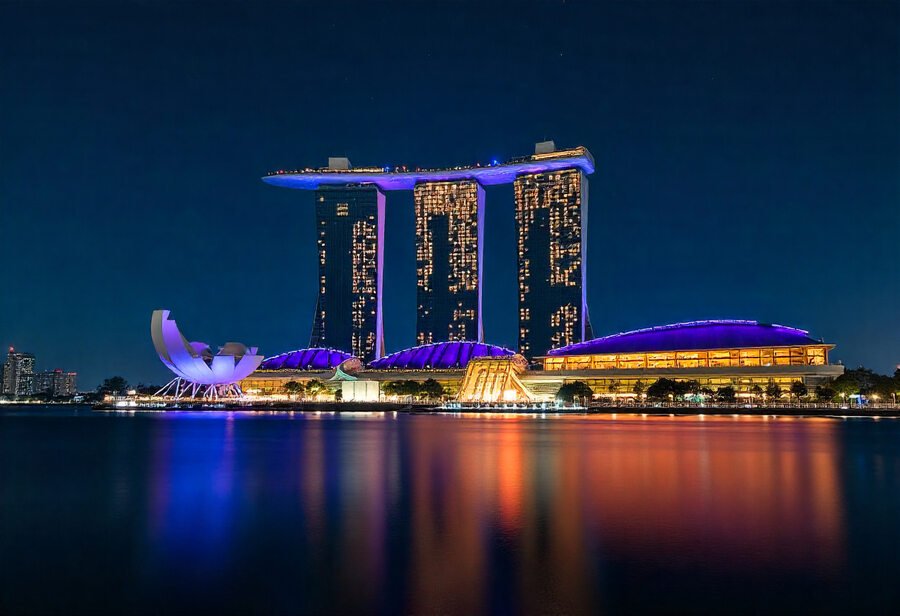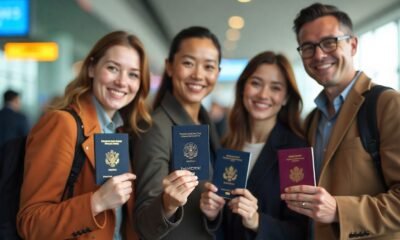Asia Travel Pulse
Gilan’s Tourism Revolution: Explore The Cultural Heart Of Iran

Wednesday, August 6, 2025
Author: TTW News Desk
Nestled in northern Iran, Gilan province is quickly becoming an important player in the country’s tourism industry. Known for its rich historical and cultural heritage, Gilan has experienced a notable increase in both domestic and international visitors. The province features breathtaking natural landscapes and historical landmarks. It is also developing its tourism infrastructure to meet the growing demand. The appointment of the new head of Gilan’s Cultural Heritage, Tourism, and Handicrafts Department has reinforced the province’s goal of becoming a leading tourism destination.
At the introduction ceremony of the new head, Vahedi emphasized Gilan’s significant potential in tourism. The province holds an important place in Iranian tourism, with its mix of historical sites, cultural treasures, and beautiful scenery attracting millions of tourists each year. Vahedi pointed out the high expectations for Gilan, especially considering its exceptional assets and growth potential.
A Province Rich in Historical and Cultural Treasures
Gilan’s tourism attractions are varied, making it a distinct destination for travelers interested in Iran’s cultural and historical heritage. One popular spot is the village of Masuleh, known for its unique architecture and stunning hillside location. The village showcases Iran’s traditional architectural style, with homes stacked on top of each other and connected by narrow, winding paths that lead visitors through its distinctive layout.
The ancient Rudkhan Castle, also called Qale Rudkhan, is another major draw in Gilan. Built during the Seljuk period, the castle stands as a testament to the province’s rich history. Located on a hilltop surrounded by lush forests, the castle provides breathtaking views of the area and is a must-see for history enthusiasts and adventure seekers alike.
Alongside these iconic landmarks, Gilan is home to the Gilan Rural Heritage Museum, which offers an engaging look at the province’s rural life. The museum highlights traditional customs, crafts, and the lifestyle of its people. It promotes the preservation of Gilan’s traditions and enhances appreciation for its rich heritage.
Growing Tourism Infrastructure in Gilan
With its quickly expanding tourism industry, Gilan has become a key focus for investment. According to Vahedi, the province needs to prioritize developing its tourism infrastructure to fully utilize its potential. This includes creating more places to stay, improving transportation networks, and enhancing services for tourists. The provincial government has taken steps to ensure Gilan continues to prosper as a tourism hub. They are investing in infrastructure to provide a smoother and more comfortable experience for visitors.
One notable initiative is the designation of five percent of national budget assets for tourism development across provinces, including Gilan. This budget aims to help build world-class tourism infrastructure in Gilan, promoting growth in the sector and encouraging domestic and foreign investment in the region.
Despite recent challenges due to the Israeli war against Iran, Gilan’s tourism sector showed impressive resilience. The province welcomed six million visitors amid the tense situation, demonstrating the strength of its tourism offerings and its ability to ensure the safety and support of visitors even during difficult times. Local officials, private sector support, and the dedication of tourism workers made it possible for tourists to have a safe and enjoyable stay in the province.
The Role of the Private Sector in Gilan’s Tourism Boom
One of the notable aspects of Gilan’s recent tourism growth is the involvement of the private sector. During the crisis caused by the Israeli war, hotels, eco-lodges, and residences throughout Gilan opened their doors to visitors at significantly reduced rates, with some accommodations available for free. This initiative, which Vahedi called an “epic move,” not only offered much-needed relief for tourists but also strengthened the bond between the local community and visitors. The private sector’s role in tourism development has been vital in keeping Gilan an appealing and accessible destination for all types of travelers.
Key Attractions in Gilan Province
- Masuleh Village: Known for its unique stepped architecture and beautiful mountain views, Masuleh attracts visitors from Iran and abroad. Its peaceful atmosphere and historical significance make it a top choice for culture and history lovers.
- Rudkhan Castle: A historical gem dating back to the Seljuk period, Rudkhan Castle is perched atop a hill amid dense forests, providing sweeping views of the region. Its ruins offer a fascinating insight into Iran’s past.
- Gilan Rural Heritage Museum: This cultural treasure provides a deep dive into the traditional lifestyles, crafts, and culture of Gilan’s rural communities. Visitors can explore exhibits that highlight local art, clothing, and agricultural practices.
Looking to the Future: Gilan’s Tourism Potential
As Gilan continues to develop as a tourism destination, the future appears promising. The mix of historical landmarks, cultural richness, and scenic beauty, combined with the government’s commitment to improving infrastructure, positions Gilan as an important player in Iran’s tourism industry. The province’s focus on attracting investors and creating a welcoming environment for visitors will certainly contribute to its ongoing success in tourism.
With the rising number of visitors to Gilan, the province is poised to maintain its momentum, bolstering its reputation as one of Iran’s most desirable tourism spots. Whether exploring tranquil villages, hiking in lush mountains, or immersing oneself in the region’s deep cultural roots, Gilan offers something for every traveler.
Conclusion: Gilan’s Bright Future in Tourism
Gilan’s rise as a tourism powerhouse highlights the province’s great potential and the dedicated efforts of both public and private sectors to offer an unforgettable experience for travelers. With ongoing investment and continued infrastructure development, Gilan is sure to solidify its status as a leading tourist destination in Iran. As the province evolves and grows, visitors can look forward to an ever-improving experience that combines the charm of its historic sites with the beauty of its landscapes. Gilan’s tourism industry is set for a bright future, providing endless opportunities for exploration and investment.
(Source: Gilan Cultural Heritage, Tourism and Handicrafts Department, Miras Arya, Iranian government, tourism sector, Gilan province, Masuleh village, Rudkhan Castle, Gilan Rural Heritage Museum, Iranian Parliament, tourism infrastructure development, private sector tourism support, Gilan tourism growth)
Asia Travel Pulse
Thailand Sets the Stage for a Tourism and Aviation Surge with VietJet’s Massive Hiring Drive and New International Routes Across Asia

Published on
August 7, 2025 |
By: TTW News Desk
Thailand is rapidly advancing its position as a regional aviation powerhouse, backed by VietJet Thailand’s aggressive expansion strategy in 2025. As Southeast Asia’s most popular travel destination rebounds from the pandemic and strengthens its infrastructure, VietJet is stepping in to meet soaring travel demand by opening over 5,000 new positions across aviation roles—ranging from pilots and engineers to cabin crew and ground staff. At the same time, the airline is rolling out a slate of new direct routes from Bangkok to major Asian destinations including Tokyo, Osaka, Seoul, Kolkata, and Ahmedabad. This dual strategy not only supports Thailand’s long-term goal to become the leading air travel hub in the region, but also fuels economic growth, boosts employment, and enhances cross-border connectivity just as international tourism to the country surges once again.
Thailand Set to Welcome Over 5,000 New Aviation Jobs as VietJet Expands Regional Operations Across Asia
Thailand’s aviation sector is preparing for a significant hiring surge as VietJet Thailand, the local arm of Vietnam’s leading budget airline, gears up to recruit more than 5,000 new employees in 2025. The expansion drive is directly tied to the airline’s ambitious plans to grow its presence in Southeast Asia’s most visited destination, positioning Thailand as a regional aviation hub.
The announcement signals a strategic leap by VietJet to strengthen its Thai operations with a wave of new flight routes to high-demand cities across Asia. The airline will roll out several new direct flights to destinations in Japan, South Korea, and India by the end of this year, seeking to capture a larger share of the booming regional travel market.
In a statement released late Wednesday, VietJet confirmed that it will begin offering new international routes from Bangkok to Seoul, Osaka, Tokyo, Kolkata, and Ahmedabad in the coming months. These routes mark a crucial expansion of the airline’s network beyond its existing short-haul offerings, signaling a broader push into long-haul, high-traffic routes linking Thailand with the rest of Asia.
Thailand’s Aviation Ambitions Receive Major Boost
VietJet’s move aligns closely with Thailand’s national agenda to become Southeast Asia’s premier air travel gateway. As the third-largest economy in the region, Thailand is aggressively upgrading its airport infrastructure in a bid to draw more airlines and travelers. Airport expansion projects in key hubs such as Suvarnabhumi Airport in Bangkok, along with upgrades at Phuket and Chiang Mai international airports, are already underway.
VietJet is one of several regional carriers responding to this opportunity. Thai Airways International Pcl and Asia Aviation Pcl, the operator of Thai AirAsia, have also added new international routes to their schedules, underscoring a wider industry trend of ramping up regional connectivity to meet surging passenger demand.
Massive Hiring Campaign Underway
To support its new flight offerings, VietJet Thailand has initiated a large-scale recruitment campaign across multiple departments. The company is hiring pilots, cabin crew, engineers, technicians, and ground support staff to meet operational requirements for the newly announced routes. While VietJet did not disclose the current size of its workforce, the hiring target of 5,000 new employees marks one of the airline’s most ambitious staffing efforts to date.
The decision to boost hiring in Thailand also reflects renewed confidence in the post-pandemic recovery of regional travel. As tourism demand rebounds, airlines are finding it essential to increase capacity, add new connections, and rebuild staffing levels that were significantly reduced during the global health crisis.
Financial Turnaround Fuels Expansion
The expansion into new routes and workforce growth comes on the heels of an impressive financial rebound by VietJet Thailand. According to data from Thailand’s Ministry of Commerce, the airline posted a net profit of 64 million baht (approximately \$1.98 million USD) in 2024. This represents a significant reversal from the 3.6 billion baht loss the airline recorded in 2023.
Revenues also saw a substantial leap, rising by 45% year-on-year to reach 19 billion baht. This strong financial performance appears to have paved the way for the airline’s current expansion efforts and strategic investment in infrastructure and personnel.
New Routes to Connect Thailand with Key Asian Cities
The rollout of VietJet’s new regional routes begins this fall and will be phased in through the end of the year:
Nonstop Flight from Bangkok to Seoul Set to Launch on October 1 as Part of VietJet’s Asia Expansion
- Bangkok to Osaka (Japan) – Launching December 1
- Bangkok to Tokyo Narita (Japan) – Beginning December 15
- Bangkok to Kolkata (India) – Starting November 16
Nonstop Bangkok to Ahmedabad Flight Set to Launch December 4 with VietJet Thailand
These additions are expected to not only increase passenger volume through Thailand but also boost economic ties with key tourism and business markets across Asia.
Legal Disputes Resolved
The airline’s latest strategic moves also follow a legal resolution in the UK. A London judge recently denied a motion by investment firm FitzWalter Capital Ltd. to freeze VietJet’s global assets in a dispute over unpaid fees. The decision removes a potential hurdle that could have impacted VietJet’s overseas operations and expansion plans.
Thailand is stepping up as a regional aviation leader with VietJet launching over 5,000 new jobs and expanding nonstop flights to major Asian cities, supporting the nation’s push to become Southeast Asia’s premier air hub.
Outlook Bright for Thailand’s Aviation Sector
With strong financial backing, growing regional demand, and government support for infrastructure upgrades, Thailand’s aviation industry is entering a new phase of accelerated growth. VietJet Thailand’s expansion, both in terms of routes and workforce, places it at the center of this transformation, signaling a competitive push to redefine regional air travel through Thailand as a central hub.
Asia Travel Pulse
Singapore Experiences The Steepest Drop In US Travel Interest Across Southeast Asia While Vietnam And Philippines Show Strong Growth In American Tourism Demand

Published on
August 7, 2025 |
By: TTW News Desk
Singapore has recorded the sharpest decline in travel interest from U.S. tourists across Southeast Asia, signaling a significant shift in American tourism patterns in the region. According to newly released travel trend data, factors such as rising costs, stricter regulations, and a perceived lack of novelty have contributed to the drop in U.S. demand for Singapore as a destination. In contrast, Vietnam and the Philippines are witnessing a surge in American travel interest, driven by their affordability, emerging beach destinations, rich cultural experiences, and relaxed visa policies. This evolving landscape highlights a growing preference among U.S. travelers for more immersive, budget-friendly, and off-the-beaten-path experiences in Asia.
Singaporeans are showing a sharp decline in interest toward traveling to the United States in 2025, signaling a significant shift in travel preferences across Southeast Asia. According to fresh findings from Milieu Insight’s “Asian Travel Demand for US” survey, carried out between late May and mid-June, only 7% of respondents in Singapore said they had increased interest in visiting the U.S. this year. In contrast, 55% said their interest had declined—marking the steepest drop among all Southeast Asian countries included in the study.
Across Southeast Asia, interest in traveling to the United States remains fairly steady, with 44% of respondents still eager to make the trip and just 18% reporting a decline in interest. However, Singapore sets itself apart with a much steeper drop. The data highlights a clear and growing hesitation among Singaporean travelers, who are increasingly choosing to leave the U.S. off their upcoming itineraries.
Safety Expectations Shape Travel Decisions
One of the leading factors behind this decline is personal safety. Singaporeans, who live in a country consistently ranked among the safest in the world, hold extremely high expectations when it comes to security while abroad. The United States, by contrast, continues to struggle with high-profile issues like mass shootings, violent crime, and unrest—creating a stark contrast that has made many Singaporeans rethink their travel plans.
Singapore’s internal safety standards play a major role in shaping outbound travel choices. With crime rates kept extremely low at home, travelers from the city-state are more likely to avoid destinations where public safety feels uncertain. In this context, the United States now faces growing scrutiny from Southeast Asia’s most security-conscious travelers.
Concerns Mount Over U.S. Firearm Policies and Border Control Issues
Concerns over gun laws are triggering serious unease among travelers. Frequent headlines about gun-related incidents and the lack of consistent firearm regulations across various U.S. states have heightened anxiety. For many in Singapore, the idea of traveling to a country where firearms are widely accessible—but public safety measures seem unreliable—feels increasingly unsettling.
Beyond gun-related concerns, U.S. immigration processes are also discouraging potential visitors. Even though Singaporeans enjoy one of the world’s most powerful passports—with visa-free or visa-on-arrival access to 193 countries and territories—many remain wary of entering the United States. According to the survey, only 60% of Singaporeans feel confident that their U.S. immigration experience would go smoothly. This figure sits far below the regional average of 78%, revealing that Singaporeans are more skeptical about how they will be received at American borders.
Past reports of extended questioning, profiling, and random checks have likely influenced these sentiments. Even travelers with clear documentation and valid travel reasons now hesitate, unsure of how they might be treated at customs or immigration checkpoints.
Discrimination and Policy Concerns Deepen Reluctance
Several other factors add to the apprehension. Singaporeans cite fears of racial discrimination, mistreatment based on appearance or background, and discomfort with current U.S. policy directions. Concerns include everything from rising hate crimes against Asians to systemic challenges in how foreigners are treated upon arrival.
The perception of the United States as a destination where foreign travelers may face hostility—whether from law enforcement, other travelers, or institutions—continues to grow. While many of these issues may be debated or interpreted differently across media sources, the end result remains clear: a growing number of Singaporeans no longer feel safe or welcome in the United States.
Cost and Visa Rules Less of a Barrier for Singaporeans
Interestingly, the usual obstacles of international travel—high costs and visa requirements—are not the primary issues for Singaporeans. As the holders of the most globally mobile passport and residents of a high-income nation, Singaporeans rarely face financial or administrative hurdles when planning long-haul trips. Their reasons for avoiding the U.S. are rooted more deeply in perceived safety risks and the possibility of negative experiences.
Unlike travelers from less economically secure countries who might weigh the price of travel more heavily, Singaporeans focus on the experience itself. They want travel to feel safe, welcoming, and enriching—and current sentiment suggests that the United States no longer meets those criteria for a significant number of them.
Divergent Regional Trends Highlight Contrast
Meanwhile, several other Southeast Asian countries are showing the opposite trend, with growing interest in traveling to the United States. According to the survey, 57% of respondents from Vietnam and 49% from the Philippines said their desire to visit the U.S. has increased compared to six months ago. Experts believe this rising interest may be influenced by the presence of large Vietnamese and Filipino communities already living in the U.S., which continue to strengthen personal, cultural, and family connections across borders.
This divergence highlights the unique outlook of Singaporeans, whose travel motivations and media consumption habits differ significantly from neighboring nations. Whereas citizens in many Southeast Asian countries rely primarily on social media for news—often filtered through influencers, memes, or viral headlines—Singaporeans still lean heavily on traditional news outlets, both domestic and international. This could shape a more cautionary and fact-driven view of world events, including travel risks.
Singapore has seen the sharpest drop in U.S. travel interest due to rising costs and stricter entry norms, while Vietnam and the Philippines are gaining momentum with affordable prices, relaxed visas, and growing appeal among American tourists seeking authentic, budget-friendly experiences.
The steep drop in Singaporean interest in U.S. travel underscores a deeper shift in how safety, immigration, and international relations now factor into travel decisions. While Americans once welcomed a steady stream of affluent, well-traveled visitors from Singapore, that flow is now slowing down, not because of economic reasons, but because of discomfort with what travelers may face once they land.
As global travel continues to rebound after pandemic disruptions, countries like the U.S. may need to do more than promote attractions and experiences—they must also rebuild trust and assure international travelers that they will be safe, respected, and treated fairly from the moment they arrive.
Asia Travel Pulse
South Korea Joins China, Japan, Thailand, And Malaysia In Driving Vietnam’s Explosive Tourism Growth As Visitor Numbers Soar Past Over Twelve Million Amid Asia’s Travel Reawakening And Bold Policy Shifts

Published on
August 7, 2025 |
By: TTW News Desk
Vietnam’s tourism industry is experiencing a remarkable resurgence, with over 12.23 million international visitors recorded in the first seven months of 2025—a 22.5% year-on-year increase. This impressive growth is largely driven by streamlined visa policies, expanded international air connectivity, and targeted promotional campaigns across key Asian markets including South Korea, China, Japan, Thailand, and Malaysia. The surge reflects Vietnam’s strategic efforts to position itself as a top-tier destination in Asia’s competitive tourism landscape.
Vietnam Sees Strong Tourism Recovery With Over 12 Million International Arrivals in First Seven Months of 2025
Vietnam’s tourism industry is gaining strong momentum in 2025, having attracted over 12.23 million international travelers in the first seven months alone—a sharp 22.5% rise from the same period last year, based on newly published government figures. This impressive upswing underscores Vietnam’s rising status as a leading travel hotspot in Southeast Asia and marks a powerful recovery phase for its broader hospitality and travel ecosystem.
A significant majority of these tourists—approximately 85.1%—arrived by air, reaffirming the importance of Vietnam’s major international airports such as Noi Bai, Tan Son Nhat, and Da Nang as critical gateways for inbound tourism. The high volume of air travel underscores the increasing connectivity between Vietnam and key global markets, as well as the attractiveness of its visa reforms and international marketing strategies.
Asia Leads the Way in Visitor Numbers
Of the 12.23 million visitors recorded between January and July, more than 9.6 million came from other Asian countries, marking a 22.4% rise compared to the same period in 2024. This strong regional demand reflects both geographic proximity and the cultural and economic ties that Vietnam shares with many Asian nations.
Tourists from countries such as China, South Korea, Japan, Thailand, and Malaysia played a major role in this growth. Regional low-cost carriers and full-service airlines have ramped up their flight schedules to and from Vietnam in response to the growing demand, and the reopening of group tours and visa-free entry for certain nationalities has made travel to Vietnam even more accessible for many Asian tourists.
Strategic Visa and Policy Measures Drive Growth
The significant growth in international arrivals is attributed in large part to a combination of progressive government policies and strategic industry coordination. Vietnam has introduced several visa facilitation measures, including extending the validity of e-visas, expanding the list of eligible countries, and simplifying entry procedures. These reforms have made it easier and faster for travelers to enter the country, boosting travel confidence and encouraging repeat visits.
In addition, Vietnam’s continued participation in regional travel agreements and diplomatic cooperation on tourism exchange has opened new doors for cross-border travel. These policies not only support increased arrival numbers but also strengthen Vietnam’s reputation as a tourism-friendly destination in the region.
Promotional Campaigns and Event Tourism Fuel Interest
Vietnam’s tourism authorities have launched multiple international marketing campaigns in recent months to promote the country’s natural beauty, rich heritage, and culinary offerings. These campaigns have included digital outreach, partnerships with influencers and travel agencies, participation in international travel fairs, and the release of promotional videos in multiple languages targeting diverse markets.
Event-based tourism has also played a crucial role in drawing international attention. From cultural festivals and national holiday celebrations to international conferences and sporting events, Vietnam has strategically positioned itself as a vibrant, year-round destination. These events not only increase visitor arrivals during specific periods but also help improve the global image of Vietnam as an active and modern nation with deep-rooted traditions.
Domestic Infrastructure and Service Improvements
To support the influx of international visitors, Vietnam has made significant investments in tourism infrastructure, including airport expansions, upgraded roads, new hotel developments, and improvements in hospitality training. These efforts are creating a more seamless and enjoyable travel experience for tourists, encouraging longer stays and higher spending.
Many popular tourist destinations such as Ha Long Bay, Hoi An, Hue, Nha Trang, and Phu Quoc have also benefited from the development of sustainable tourism initiatives and eco-friendly travel programs. These efforts are part of a broader national strategy to balance growth with environmental and cultural preservation.
Outlook for the Rest of the Year
With peak travel seasons approaching and additional events on the calendar, tourism officials remain optimistic about maintaining strong momentum for the rest of 2025. Continued recovery in long-haul markets, including Europe and North America, combined with growing interest from regional neighbors, is expected to push total international arrivals closer to or even beyond pre-pandemic levels.
Vietnam’s tourism performance in the first seven months of 2025 reflects not only a recovery from past disruptions but also the strategic planning and forward-looking vision that now drives the country’s tourism agenda. As global travel trends continue to evolve, Vietnam appears well-positioned to remain a leading destination in Asia and beyond.
-

 Brand Stories2 weeks ago
Brand Stories2 weeks agoBloom Hotels: A Modern Vision of Hospitality Redefining Travel
-

 Brand Stories2 weeks ago
Brand Stories2 weeks agoCheQin.ai sets a new standard for hotel booking with its AI capabilities: empowering travellers to bargain, choose the best, and book with clarity.
-

 Destinations & Things To Do3 weeks ago
Destinations & Things To Do3 weeks agoUntouched Destinations: Stunning Hidden Gems You Must Visit
-

 Destinations & Things To Do2 weeks ago
Destinations & Things To Do2 weeks agoThis Hidden Beach in India Glows at Night-But Only in One Secret Season
-

 AI in Travel3 weeks ago
AI in Travel3 weeks agoAI Travel Revolution: Must-Have Guide to the Best Experience
-

 Brand Stories1 month ago
Brand Stories1 month agoVoice AI Startup ElevenLabs Plans to Add Hubs Around the World
-

 Brand Stories4 weeks ago
Brand Stories4 weeks agoHow Elon Musk’s rogue Grok chatbot became a cautionary AI tale
-

 Brand Stories2 weeks ago
Brand Stories2 weeks agoContactless Hospitality: Why Remote Management Technology Is Key to Seamless Guest Experiences
-

 Asia Travel Pulse1 month ago
Asia Travel Pulse1 month agoLooking For Adventure In Asia? Here Are 7 Epic Destinations You Need To Experience At Least Once – Zee News
-

 AI in Travel1 month ago
AI in Travel1 month ago‘Will AI take my job?’ A trip to a Beijing fortune-telling bar to see what lies ahead | China













You must be logged in to post a comment Login